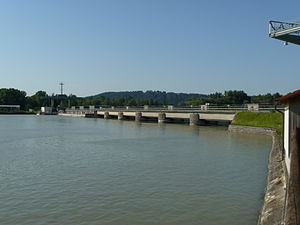Ering-Frauenstein power plant
| Ering-Frauenstein power plant | ||
|---|---|---|
| View of the power station from Frauenstein | ||
| location | ||
|
|
||
| Coordinates | 48 ° 17 '23 " N , 13 ° 9' 39" E | |
| country | Germany / Austria | |
| place | Ering / mining | |
| Waters | Inn | |
| Kilometers of water | km 48 | |
| Height upstream | 336.2 m above sea level NN | |
| power plant | ||
| owner | Innwerk AG (50%) / Verbund Hydro Power AG | |
| operator | Grenzkraftwerke GmbH | |
| Start of planning | 1936 | |
| construction time | 1939-1942 | |
| Start of operation | 1942 | |
| technology | ||
| Bottleneck performance | 72.9 megawatts | |
| Average height of fall |
9.65 m | |
| Expansion flow | 1040 m³ / s | |
| Standard work capacity | 437.7 million kWh / year | |
| Turbines | 3 Kaplan turbines | |
| Generators | 3 synchronous generators | |
| Others | ||
| Website | Ering-Frauenstein | |
The Ering-Frauenstein power plant is a run -of-river power plant on the lower Inn River operated by the Österreichisch-Bayerischen Kraftwerke AG (ÖBK) . Its facilities are located in the municipalities of Ering ( Lower Bavaria ) and Mining ( Upper Austria ). The power house is located near the Bavarian bank, while the movable elements of the dam are located near the Austrian bank. The switchgear is also on the Bavarian side.
history
In 1936 Siemens-Schuckertwerke AG presented a design for the construction of five hydropower plants on the lower Inn. This draft was modified in a further master plan in 1938. With the start of the construction of the Ranshofen aluminum smelter in July 1938, Innwerk AG was commissioned to build the Ering-Frauenstein and Egglfing-Obernberg power plants in accordance with the 1938 framework plan for powering the aluminum smelter. On July 4, 1938, the Siemens-Schuckertwerke (SSW) preliminary project was submitted to the authorities and a little later Innwerk AG began construction. Work began on February 9, 1939 with the rounding of the first excavation pit A on the right bank of the Inn, the place that is now occupied by the three eastern weir openings. The middle construction pit B, the location of which today encompasses the three western weir fields, was next encircled and pumped empty on February 17, 1940. After minor damage from a flood on June 1, 1940, the last construction pit C, which was intended for the power house, was finally rammed and drained from December 20, 1940. The impoundment began on July 9, 1942 and the first machine set was put into operation about a month later. The other two machine sets were connected to the network on September 1, 1942, on October 11, 1942 and on January 31, 1943, after they were fully jammed.
technology
The current expansion capacity of the plant is 72.9 MW . Electricity is generated by three vertically installed Kaplan turbines from JM Voith GmbH . The nominal output per turbine is 25 MW each; the directly attached shield generators with exciter machines from AEG have a nominal output of 30 MVA each. The weight of each turbine runner is 110 t, the rotor of each generator 196 t. The generator voltage is increased from 10.5 kV to 110 kV in three 30 MVA power transformers from SSW and conducted via overhead lines to the St. Peter substation, the Obernberg-Egglfing power plant below and the Ranshofen aluminum plant .
In addition, another, smaller Kaplan turbine is supplied by JM Voith GmbH. with an output of 1,324 kW and an AEG three-phase generator, electricity for the own use of the power plant and the five pumping stations. If this self-supply system fails, a diesel emergency generator with 147 kW from MAN , built in 1940, is available.
Like the other power plants on the lower Inn , Ering-Frauenstein does not have a lock . Upstream, the storage space that can be used for energy generation is limited by the Braunau-Simbach power plant , and downstream by the Egglfing-Obernberg power plant .
See also
Web links
Individual evidence
- ↑ Österreichische Zeitschrift für Elektrizitätswirtschaft, Volume 20, May 1967, Issue 5, pp. 170–171


